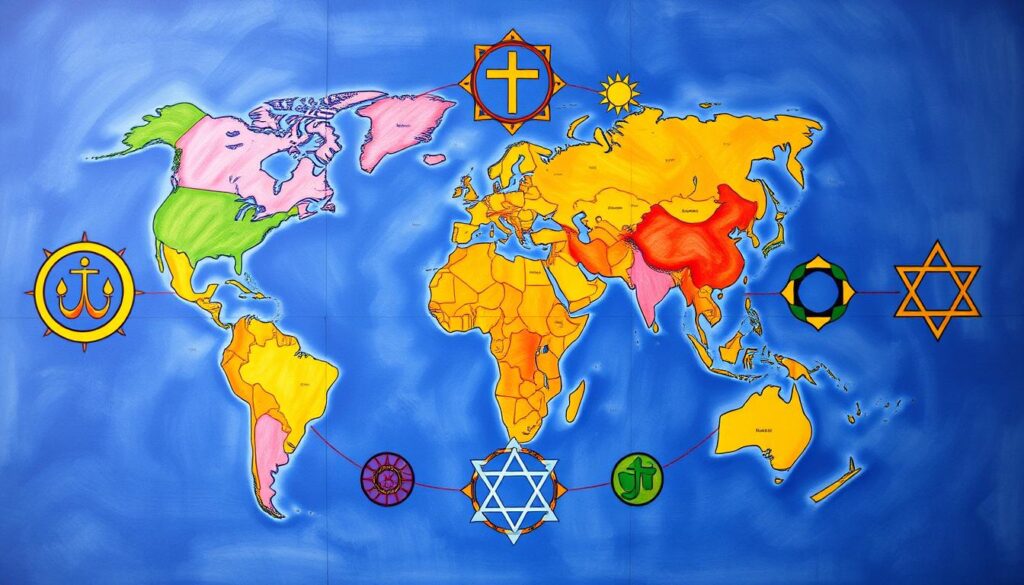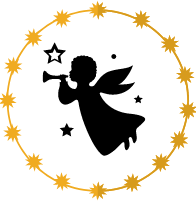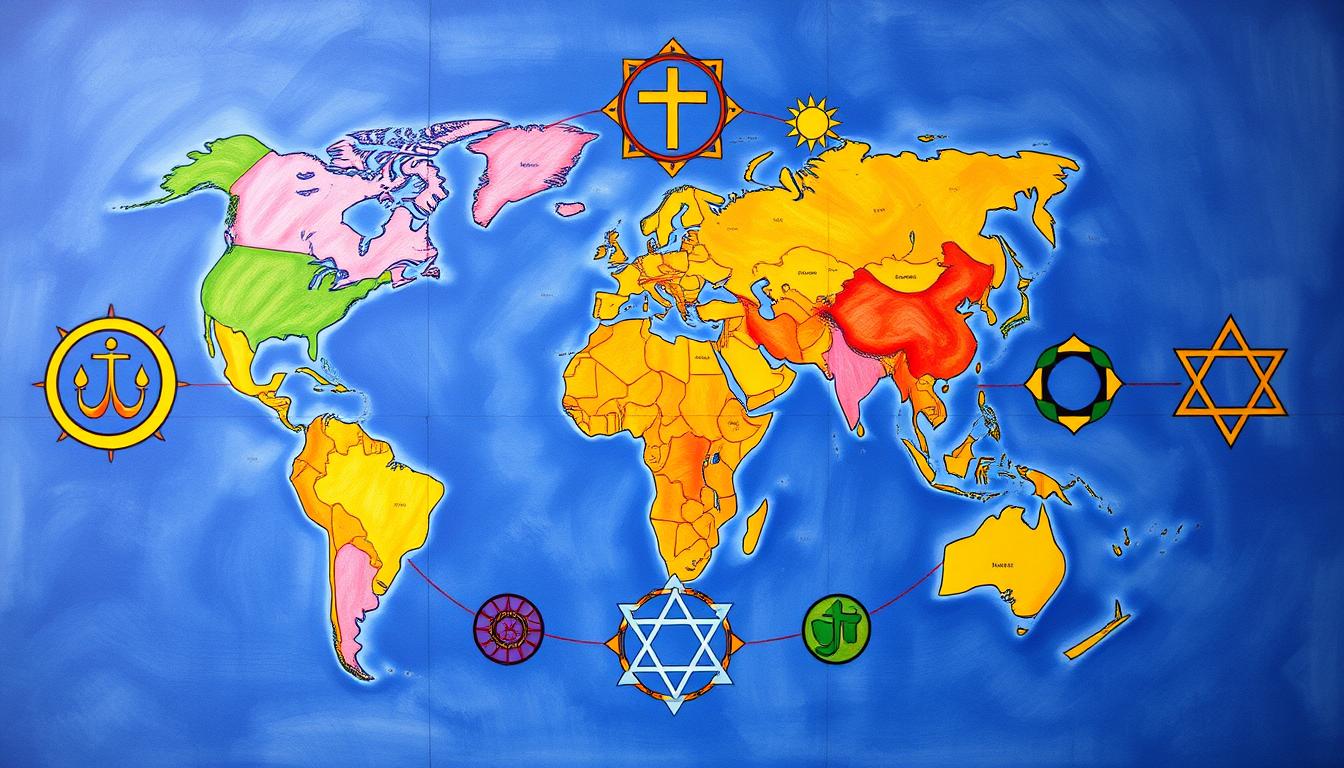I’ve been thinking a lot about how many religions there are in the world. It’s a big question. Experts say there are about 4,200 different religions out there. This shows how rich and varied our spiritual beliefs are.
Welcome to checkreligion.com
How Many Religions Are There in the World !
Also, over 85% of people around the world belong to a religion. This shows how important world faiths quantity is in our cultures and societies. But, it’s hard to count them all because new ones keep coming and old ones stay.
From big religions to small ones, each adds its own special touch. They all make up the big picture of faith on our planet.
Key Takeaways
- There are approximately 4,200 distinct religions worldwide.
- More than 85% of the global population aligns with a religious group.
- Major world religions form a significant part of the global religions count.
- The dynamic nature of faith contributes to the evolving landscape of religion.
- Religious diversity includes both mainstream faiths and lesser-known indigenous traditions.

Understanding the Concept of Religion
The concept of religion is very important in our world. It helps shape who we are and how we live together. It’s about beliefs, practices, and values that connect us to something bigger than us.
When we look at belief systems, we see that religions help us understand life and right and wrong. They guide us on how to connect with something greater than ourselves.
Over time, how we see religion has changed a lot. It started from a Latin word meaning “careful” and now includes many different beliefs. Scholars have found common ideas in religions, like believing in a higher power and following certain practices.
These ideas help create a sense of community and identity. They show us what’s important in most religions.
Religions are very different from each other. Some, like Christianity and Islam, have clear rules and rituals. Others, like folk religions, are more flexible. Religion does more than just help us believe; it shapes our society and gives us comfort when things are tough.
Today, there are about 10,000 different religions around the world. Big religions like Christianity, Islam, Hinduism, and Buddhism make up more than 77% of people. Religion helps us find meaning and truth in our lives.

| Belief System | Description | Major Practices |
|---|---|---|
| Christianity | Monotheistic religion based on the life and teachings of Jesus Christ. | Sacraments, prayer, community worship. |
| Islam | Monotheistic faith following the teachings of Muhammad as revealed in the Quran. | Five Pillars, daily prayers, charity. |
| Hinduism | Complex belief system with multiple deities and a variety of practices. | Puja, meditation, yoga. |
| Buddhism | Philosophical system centered on personal spiritual development and enlightenment. | Meditation, mindfulness, ethical living. |
| Folk Religions | Local belief systems often intertwined with cultural practices. | Ceremonies, rituals, oral traditions. |
The Total Religions Around the World
There are many faiths around the world. Researchers say there are about 4,200 religions. This shows how different and varied they are.
Estimations of Religious Groups
About 85% of people worldwide follow a religion. Big religions have lots of followers:
| Religion | Estimated Followers (Billions) | Percentage of Global Population |
|---|---|---|
| Christianity | 2.4 | 31% |
| Islam | 2.0 | 24% |
| Hinduism | 1.2 | 15% |
| Buddhism | 0.5 | 7% |
| Judaism | 0.014 | 0.2% |
| Folk/Traditional Religions | 0.4 | 6% |
Identifying Major and Minor Faiths
Big religions like Christianity and Islam make up most followers. But there are also many smaller faiths. These include local traditions and new religions. Knowing about these helps us see how diverse beliefs are.
How Many Religions Are There in the World
There are thousands of religions worldwide. They show a wide range of beliefs and practices. We can group them into big categories. This section looks at both big faiths and small, traditional ones that shape cultures and communities.
Breakdown of Major Religions
The largest religions in the world are:
| Religion | Adherents (in billions) | % of Global Population |
|---|---|---|
| Christianity | 2.38 | 31% |
| Islam | 1.91 | 24% |
| Hinduism | 1.16 | 15% |
| Buddhism | 0.507 | 7% |
| Folk Religions | 0.430 | 6% |
| Judaism | 0.0146 | 0.2% |
| Unaffiliated/Agnostic/Atheist | 1.19 | 16% |
This breakdown shows a diverse religious world. Christianity, Islam, and Hinduism are big. Each has many sects and denominations, showing the complexity of faith.

Minor Religions and Traditional Belief Systems
Minor religions like Sikhism and Jainism add to the world’s beliefs. Folk traditions also play a big role. They help keep cultural identity alive, especially in indigenous tribes.
It’s important to understand the diversity of religions. Recognizing the value of both big and small faiths helps us appreciate our cultural heritage. It also promotes dialogue that brings us together.
Global Religions Count: The Major Faiths
Religion shapes cultures and societies worldwide. Some major faiths have many followers and a long history. I’ll talk about Christianity, Islam, Hinduism, and Buddhism. We’ll look at what makes each unique and how many people follow them.
Christianity: The Largest Religion
Christianity is the biggest religion, with about 2.4 billion followers. It’s big in the Americas, Europe, and Africa. It’s based on Jesus Christ’s teachings and has changed Western history and culture a lot.
Islam: The Fastest Growing Religion
Islam is growing fast, with nearly 1.9 billion followers. It’s growing in Northern Africa and South Asia. It’s about following the Prophet Muhammad and believing in Allah.
Hinduism: An Ancient Tradition
Hinduism is very old, with about 1.2 billion followers. It started in ancient India. It’s big in India and Nepal, where many festivals and rituals happen.
Buddhism: The Path of Enlightenment
There are about 500 million Buddhists. Buddhism helps people find enlightenment and freedom. It started in India and is big in East and Southeast Asia. It teaches about compassion and being mindful.
| Religion | Followers (in billions) | Key Regions |
|---|---|---|
| Christianity | 2.4 | Americas, Europe, Africa |
| Islam | 1.9 | Northern Africa, South Asia |
| Hinduism | 1.2 | India, Nepal |
| Buddhism | 0.5 | China, Thailand |
Religious Diversity Statistics
Religious diversity statistics show the many beliefs around the world. About 4,300 different religions are practiced. This shows a rich cultural mix, influenced by where people live and move.
Different places have their own religious identities. These are shaped by history and social life.
Percentage of Population by Religion
In 2023, the world’s religious makeup is interesting. Christianity is the biggest faith, with 30.7% of people. Islam is second, with 24.9%.
Hinduism is practiced by 15.1% of people. Buddhism is at 6.6%, and folk religions at 5.6%. Sikhism and Judaism make up 0.3% and 0.2%, respectively.
| Religion | Percentage of Population |
|---|---|
| Christianity | 30.7% |
| Islam | 24.9% |
| Unaffiliated | 15.6% |
| Hinduism | 15.1% |
| Buddhism | 6.6% |
| Folk religions | 5.6% |
| Sikhism | 0.3% |
| Other religions | 1.2% |
Geographical Distribution of Religions
Religions are spread out in different ways around the world. The Asia-Pacific area has the most religious diversity. Countries like Singapore and Vietnam show this.
In sub-Saharan Africa, places like Togo and Ivory Coast have a lot of religions too. But North America and Europe have less diversity. The United States is 68th in diversity, and France is 25th.
The Middle East and parts of Latin America have even less variety. This shows how religion changes from place to place.
Religions Worldwide Number: An Overview
Looking at the religions worldwide number gives us a peek into the many beliefs around the world. We see the big branches of religions and their important sects. We also notice how new religious movements are growing.
From old faiths to new ideas, spirituality today is complex. It shows both old traditions and new ways of thinking.
Major Branches of Religions
Major branches of religions show the wide range of spiritual practices. Here’s a quick look:
| Religion | Adherents (in millions) | Branches/Sects |
|---|---|---|
| Christianity | 2,500 | Roman Catholicism, Protestantism, Orthodoxy |
| Islam | 1,900 | Sunni, Shia |
| Hinduism | 1,160 | Vaishnavism, Shaivism |
| Buddhism | 507 | Mahayana, Theravada |
| Folk Religions | 430 | N/A |
| Judaism | 14.6 | Orthodox, Conservative, Reform |
| New Religious Movements | 67.5 | N/A |
Emerging Religious Movements
New religious movements are a response to changing times. They offer new views and ways to practice spirituality. These movements can be new takes on old religions or something entirely new.
These new followers add a lot to the number of religions worldwide. Their influence is growing. The variety in these movements shows how society today connects with spirituality.
Exploring Folk and Traditional Religions
Folk religions are a mix of local beliefs and traditions. They are shaped by culture, land, and community practices. These traditions often include honoring ancestors and rituals that connect people to their roots.
Folk religions are key to many societies. They show us the values and customs of the communities that follow them.
Characteristics of Folk Religions
Folk religions have some key traits:
- Local customs: Practices vary by region, showing the unique histories of different groups.
- Rituals and festivals: Many celebrate seasonal changes or agricultural cycles with lively festivals. These festivals help strengthen community bonds.
- Ancestral veneration: Honoring ancestors is very important. These beliefs guide moral and ethical behavior in communities.
- Spiritual connection to land: The environment is deeply connected to many traditional beliefs. Natural features are seen as spiritually significant.
Impact of Traditional Beliefs on Society
Traditional beliefs have a big impact on society. They influence many areas such as:
- Cultural identity: Folk religions help keep cultural heritage alive. They are passed down through generations, keeping community identity strong.
- Social cohesion: Shared beliefs bring people together. They create a sense of belonging, fostering unity and cooperation.
- Ethical framework: These religions guide moral behavior. They shape how people act and what standards the community follows.
The Non-Religious Population in the World
The world is changing how people see religion. More people are saying they don’t follow any religion. This change is big in places that value being free to believe what you want.
Growth of Non-Religious Individuals
More people are not tied to any religion all over the world. By 2010, about 1.1 billion people said they didn’t follow any religion. This number is expected to go up to over 1.2 billion by 2050.
This growth isn’t the same everywhere. Even though more people are not religious, they make up a smaller part of the world’s population. In the United States, more people are saying they don’t follow any religion. This shows a big change in how people think.
Atheism, Agnosticism, and Spiritual but Not Religious
There are different kinds of non-religious people. Some don’t believe in any gods. About 9% of the world’s people say they are convinced atheists.
This is more common in places that are not very religious. Some people say they are “spiritual but not religious.” They look for spiritual connections in ways that aren’t tied to traditional religions. This shows that people can be spiritual in many different ways.
| Year | Percentage of Non-Religious Population | Projected Growth (Worldwide) |
|---|---|---|
| 2010 | 16% | 1.1 billion |
| 2022 | Estimated 21% (USA) | N/A |
| 2050 | 13% | Over 1.2 billion |
Conclusion
Looking at world religions, I see a big and complex mix of beliefs. There are about 4,200 recognized religions. Each one tells its own story, helping us understand humanity’s search for meaning.
Big faiths like Christianity, Islam, and Hinduism, and smaller folk beliefs, show how our spiritual paths change. They help us deal with today’s big issues.
Religions have different groups, like different branches of Christianity or Buddhism. But these groups don’t fully show how faith works. Religions come from our need to connect with something bigger than us.
They must change to stay important in a world that keeps changing. They face challenges like unfairness and moral problems.
Now, more people say they don’t follow any religion. But finding truth is still important to many. Looking for spirituality can be a deep and personal journey.
This talk about world religions invites us to find our own beliefs. It’s about exploring and learning, and it makes our world richer.
FAQ
How many religions are there in the world?
There are about 4,200 different religions worldwide. This shows how diverse beliefs are globally.
What are the major world religions?
Major religions include Christianity, Islam, Hinduism, and Buddhism. These faiths make up about 85% of the world’s population. They greatly influence culture and society.
What are minor religions?
Minor religions are faiths like Sikhism, Jainism, and folk traditions. They may have fewer followers but add to the world’s religious variety.
How does geographical distribution affect religions?
Where people live affects their religious beliefs. For example, Christianity is big in the Americas. Hinduism is common in South Asia. This shows how culture and religion mix.
What percentage of the global population identifies with a religion?
Over 85% of people worldwide follow a religion. This shows how important religions are to society.
What role do folk religions play?
Folk religions keep cultural traditions alive. They offer moral and ethical guidance, especially to indigenous tribes.
How is the non-religious population growing?
About 16% of people don’t follow any religion. This number is rising, especially in places like China and Japan.

